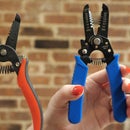Introduction: Film a Motorcycle
Motorcycle riding is fun, but capturing good video of a rider on a moving bike can be difficult. What follows are the details of an attempt to film an interview aboard my motorcycle, with whatever equipment and friends Maria and I could gather. There are certainly more ways to film a moving subject than discussed here, and I'd love to hear your suggestions in the comments!
Warning! Don't hurt yourself, others, or do anything illegal! My friends and I are professionals with a lot of experience and understand the risks involved. Do not attempt to operate a camera from outside a moving vehicle. Keep speeds low and drivers undistracted. Safety should be your number one priority!
To keep up with what I'm working on, follow me on YouTube, Instagram, Twitter, Pinterest, and subscribe to my newsletter. As an Amazon Associate I earn from qualifying purchases you make using my affiliate links.
Step 1: Communication Equipment
The two motorcycle riders' helmets have intercom systems, both Sena brand (SMH10R and SMH10) .
To communicate directions and blocking, a passenger in the car used long range wireless radios to feed directions and blocking to the motorcycle driver. This was a one-way communication as the driver could not easily activate the microphone. However later on in the Audio Capture section you'll see how the car could hear both riders.
Step 2: Video Equipment
The star of the video show when it comes to stabile action shots is the DJI Osmo, which is a 4K camera stabilized by a motorized gimbal. I just got this new fun toy and this video shoot was the perfect excuse to get to know it a bit better.
We also used a GoPro Hero Session on the hood of our follow vehicle using a Panavise suction mount. When riding alone, I put this camera on my helmet, chest harness, or suctioned to my gas tank. But for being filmed, we wanted to keep the subjects camera-free.
Inside the car we had a two Panasonic GH4s, one side-mounted upside down with a Joby gorillapod and the other handheld.
The Osmo and GH4s both capture in 4K, and since we're editing in 1080, we can use that extra space to stabilize the shots in the editing software, plus crop out the occasional time when the car mirror or antenna entered the shot.
Step 3: Audio Capture Equipment
Our audio setup was expertly operated by a generous friend who records sound professionally. Both riders wore wireless lavalier microphones: Lectrosonics SMV transmitters on block 21 snd 22 (with DPA discreet lavs covered with rycote overcovers) whose receivers (411s) connected to a battery operated 788 recorder/mixer. An old xlr -> 3.5mm cable I made came in handy for monitoring the audio mix over the car stereo's aux input.
Both GH4s were topped with Sennheiser AVX EKP wireless receivers on the same channel receiving a mix out of the 788's mic channels.





